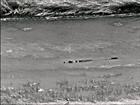Commandos over the Outback
You don’t see this on Blue Planet. Caught on the state-of-the-art electro/optic camera on a Royal Marines Wildcat helicopter a crocodile moves through a river in Australia’s Northern Territory.
British aviators made full use of their new battlefield reconnaissance helicopters as they paid a rare visit to Darwin.
A detachment of two Wildcats and more than 30 sailors and Royal Marines (and one US Marine Corps pilot on exchange) from 847 Naval Air Squadron is assigned to the French assault ship FS Dixmude for France’s key Asiatic deployment of the year: Jeanne d’Arc.
After visits and exercises around the Pacific Rim – most recently Indonesia and its large-scale Komodo exercise – the Dixmude and her escorting frigate FS Surcouf sailed into the remote Australian port for a short visit.
847 used Darwin as a changeover port with many of the personnel who’d completed the first half of the deployment heading home to Yeovilton in Somerset… with their replacements heading in the opposite direction.
As soon as the changeover was complete, aircrew headed out over the very sparsely populated terrain around Darwin to hone their navigation skills, flying side-by-side with a French Alouette helicopter.
It was a fantastic to experience the Outback which we’d seen on the ground from the air and working closely with the French was a real pleasure
Lieutenant Paul Melling, training officer for the 847 detachment
“The Alouette I fly is 53 years old – the first flight of the model was in 1959,” explained Lieutenant Henri, Dixmude’s Alouette pilot.
“This was my first time flying with the British detachment – it was very interesting having two aircraft from two very different generations flying together. A good contrast of the old and the very new.”
Lt Paul Melling, the training officer for the 847 detachment added, “It was a fantastic to experience the Outback which we’d seen on the ground from the air and working closely with the French was a real pleasure.
“It also allowed us to practise some reconnaissance skills on the local crocodile population.”
Such as using the electro-optic camera, which can see objects several miles away by day or night, in colour or black and white, and record it in high definition.
Back onboard the Dixmude, the newly-arrived Wildcat crews need to show they were ready for all eventualities during the remainder of the Jeanne d’Arc deployment: winching people and supplies, search and rescue duties, landing and taking off by day and night, and transferring loads between the two ships in the force.
The French were impressed by the hi-line method used by the British aviators to safely winch people up from particularly tight spots, such as yachts, as well as their efficiency in shifting loads between the Dixmude and Surcouf.
The French set aside three hours to move 16 loads of 500kg of ammunition apiece. The Wildcat fliers did it in two.
It’s not all work for the eclectic mix of British, French, Americans and Spanish aboard the Dixmude.
For French Navy day – May 23rd – Dixmude’s well dock, normally used for landing craft operations, was turned into a swimming pool.
847 personnel joined the ship’s aviation department and helped them to third place in the relay competition, which required sailors in pairs to complete two lengths of the 50m ‘pool’.





